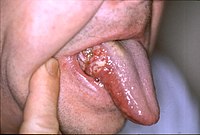
Photo from wikipedia
Abstract. Significance: Near-infrared fluorescence molecular endoscopy (NIR-FME) is an innovative technique allowing for in vivo visualization of molecular processes in hollow organs. Despite its potential for clinical translation, NIR-FME still… Click to show full abstract
Abstract. Significance: Near-infrared fluorescence molecular endoscopy (NIR-FME) is an innovative technique allowing for in vivo visualization of molecular processes in hollow organs. Despite its potential for clinical translation, NIR-FME still faces challenges, for example, the lack of consensus in performing quality control and standardization of procedures and systems. This may hamper the clinical approval of the technology by authorities and its acceptance by endoscopists. Until now, several clinical trials using NIR-FME have been performed. However, most of these trials had different study designs, making comparison difficult. Aim: We describe the need for standardization in NIR-FME, provide a pathway for setting up a standardized clinical study, and describe future perspectives for NIR-FME. Body: Standardization is challenging due to many parameters. Invariable parameters refer to the hardware specifications. Variable parameters refer to movement or tissue optical properties. Phantoms can be of aid when defining the influence of these variables or when standardizing a procedure. Conclusion: There is a need for standardization in NIR-FME and hurdles still need to be overcome before a widespread clinical implementation of NIR-FME can be realized. When these hurdles are overcome, clinical outcomes can be compared and systems can be benchmarked, enabling clinical implementation.
Journal Title: Journal of Biomedical Optics
Year Published: 2022
Link to full text (if available)
Share on Social Media: Sign Up to like & get
recommendations!